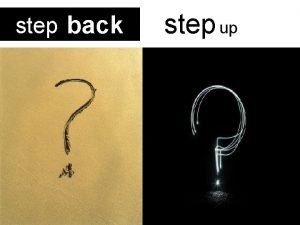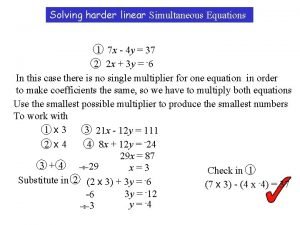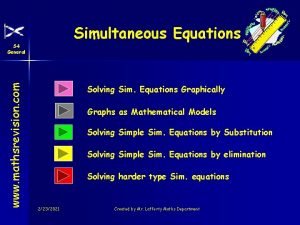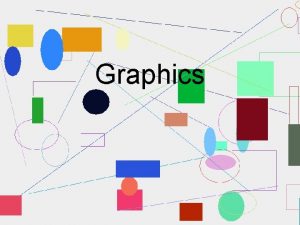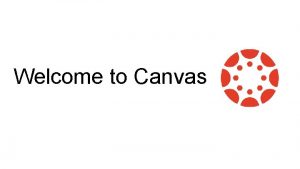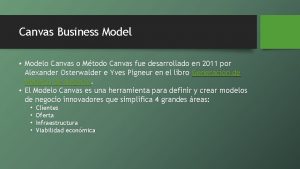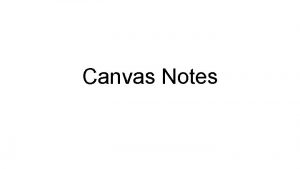Javascript canvas graphics Step 1 Find the Canvas















- Slides: 15

Javascript canvas graphics Step 1: Find the Canvas Element This is done by using the HTML DOM method get. Element. By. Id(): var canvas = document. get. Element. By. Id("my. Canvas"); Step 2: Create a Drawing Object The get. Context() returns a built-in HTML object, Canvas. Rendering. Context 2 D, with properties and methods for drawing in 2 D. var ctx = canvas. get. Context("2 d"); Step 3: Draw on the Canvas Draw a rectangle Set the fill style of the drawing object to the color red: ctx. fill. Style = "#FF 0000"; The fill. Rect(x, y, width, height) method draws a rectangle, filled with the fill style, on the canvas: ctx. fill. Rect(0, 0, 150, 75); Draw a line ctx. move. To(0, 0); ctx. line. To(200, 100); ctx. stroke(); Draw a circle ctx. begin. Path(); ctx. arc(95, 50, 40, 0, 2*Math. PI); ctx. stroke();

<!DOCTYPE HTML> <canvas id= "canvas" width="600 px" height="300 px"></canvas> <script> var point. Size = 10; draw. Coordinates(canvas. width/2, canvas. height/2); function draw. Coordinates(x, y){ var c = document. get. Element. By. Id("canvas"). get. Context("2 d"); c. fill. Style = ‘red’; // Red color c. begin. Path(); c. arc(x, y, point. Size, 0, Math. PI * 2, true); c. fill(); } draw. Coordinates(x, y) </script> draws </html> red circle at (x, y)

<!DOCTYPE HTML> <canvas id= "canvas" width="600 px" height="300 px"></canvas> <script> var point. Size = 3; document. get. Element. By. Id("canvas"). add. Event. Listener("click", get. Position); function get. Position(event){ var x = event. client. X ; var y = event. client. Y; draw. Coordinates(x, y); } Mouse click draws red circle function draw. Coordinates(x, y){ var c = document. get. Element. By. Id("canvas"). get. Context("2 d"); c. fill. Style = ’red’; // Red color c. begin. Path(); c. arc(x, y, point. Size, 0, Math. PI * 2, true); c. fill(); } </script> </html>

<!DOCTYPE HTML> <canvas id= "canvas" width="600 px" height="300 px"></canvas> <script> var point. Size = 3; var culoare=['red', yellow', 'green']; document. get. Element. By. Id("canvas"). add. Event. Listener("click", get. Position); function get. Position(event){ var x = event. client. X ; var y = event. client. Y; var b = event. button; draw. Coordinates(x, y, b); } function draw. Coordinates(x, y, b){ var c = document. get. Element. By. Id("canvas"). get. Context("2 d"); //document. write(Math. random()*3); c. fill. Style = culoare[b]; // b=0 red color left button // b=1 yello color middle button // b=2 green color right button c. begin. Path(); c. arc(x, y, point. Size, 0, Math. PI * 2, true); c. fill(); } </script>

document. get. Element. By. Id("canvas"). add. Event. Listener(“mousemove", get. Position); document. get. Element. By. Id("canvas"). add. Event. Listener("mousemove", get. Position); document. get. Element. By. Id("canvas"). add. Event. Listener("click", change. Size); function change. Size(){ point. Size+=1; } //red green blue - integer numbers bwtween 0 and 255 function RGB ( red, green, blue){ var c =0 x 1000000+ blue + 0 x 100 * green + 0 x 10000 *red ; return '#'+c. to. String(16). substr(1); } r=x%256; g=(y)%256; b=(x*y)%256; c. fill. Style=RGB (r, g, b);

<!DOCTYPE HTML> <body> <canvas id="canvas" width="600 px" height="300 px"></canvas> <script> var point. Size = 3; document. get. Element. By. Id("canvas"). add. Event. Listener("mousedown", function(){get. Position(event, 'red'); } ); document. get. Element. By. Id("canvas"). add. Event. Listener("mouseup", function(){get. Position(event, 'yellow'); } ); function get. Position(event, color ){ var x = event. client. X; var y = event. client. Y; draw. Coordinates(x, y, color ); } function draw. Coordinates(x, y, color){ var c = document. get. Element. By. Id("canvas"). get. Context("2 d"); c. fill. Style=color; c. begin. Path(); c. arc(x, y, point. Size, 0, Math. PI * 2, true); c. fill(); } </script> </body> </html>

document. get. Element. By. Id("canvas"). add. Event. Listener("mousedown", function(e){color='red'; } ); document. get. Element. By. Id("canvas"). add. Event. Listener("mouseup", function(e){color='yellow'; } ); document. get. Element. By. Id("canvas"). add. Event. Listener("mousemove", function(e){get. Position(e, color); } ); document. get. Element. By. Id("canvas"). add. Event. Listener("mousedown", get. Position ); function draw. Coordinates(x, y){ var c = document. get. Element. By. Id("canvas"). get. Context("2 d"); c. fill. Style=color; c. begin. Path(); c. move. To(0, 0); c. line. To(x, y); c. stroke(); }

document. get. Element. By. Id("canvas"). add. Event. Listener("mousedown", do. Mouse. Down); document. get. Element. By. Id("canvas"). add. Event. Listener("mouseup", do. Mouse. Up); var c = document. get. Element. By. Id("canvas"). get. Context("2 d"); function do. Mouse. Down(event) { x=event. page. X; y=event. page. Y; c. begin. Path(); c. move. To(x, y); } function do. Mouse. Up(event) { x=event. page. X; y=event. page. Y; c. line. To(x, y); c. stroke(); }

document. get. Element. By. Id("canvas"). add. Event. Listener("mousedown", do. Mouse. Down); var i=0; function do. Mouse. Down(event) { var c = document. get. Element. By. Id("canvas"). get. Context("2 d"); x=event. page. X; y=event. page. Y; i++; i%=2; If var i =true boolean if(i==1){ write the code! c. begin. Path(); c. move. To(x, y); } if(i==0){ c. line. To(x, y); c. stroke(); c. close. Path(); } }

var i=0, x 1, y 1; function do. Mouse. Down(event) { var c = document. get. Element. By. Id("canvas"). get. Context("2 d"); x=event. page. X; y=event. page. Y; i++; i%=2; if(i==1){ x 1=x; y 1=y; } if(i==0){ c. fill. Style='red'; c. rect(x 1, y 1, x-x 1, y-y 1); c. fill(); } }

var i=0, x 1, y 1; function do. Mouse. Down(event) { x=event. page. X; y=event. page. Y; if(i==0){ x 1=x; y 1=y; i=1; } if(ii==1 && (x!=x 1 && y!=y 1) ){ var c = document. get. Element. By. Id("canvas"). get. Context("2 d"); c. fill. Style='red'; c. rect(x 1, y 1, x-x 1, y-y 1); c. fill(); i=0; } }

function do. Mouse. Down(event) { var c = document. get. Element. By. Id("canvas"). get. Context("2 d"); vx=event. page. X/10; vy=(canvas. height-event. page. Y)/10; x=0, y=canvas. height, g=1, dt=1; //deseneaza o traiectorie parabolica for(i=0; i<100; i++) { c. begin. Path(); c. move. To(x, y); x += vx*dt; y += -vy*dt; vx += 0; vy += -g*dt; c. line. To(x, y); c. stroke(); } }

if( (x-x 0)*(x-x 0)+ (y-y 0)*(y-y 0)<r*r ) { alert("Ai nimerit tinta!"); }

<!DOCTYPE HTML> <body> <span id="emo" style="font-size: 10 px" meta charset="UTF-8"> &#x 1 F 601 U+1 F 601</span> <p>Copy-paste emoji at !!! symbol</p> <span id="emo 2" style="font-size: 1 em"> !!�� U+1 F 601</span> <script> document. add. Event. Listener("click", change. Size); var q=0 x 1 F 601; function change. Size(event){ document. get. Element. By. Id("emo"). style. font. Size= parse. Float(document. get. Element. By. Id("emo"). style. font. Size)+10+"px"; document. get. Element. By. Id("emo 2"). style. font. Size= parse. Float(document. get. Element. By. Id("emo 2"). style. font. Size)+0. 2+"em"; q+=1; document. get. Element. By. Id("emo"). inner. Text = String. from. Code. Point(q)+"U+"+q. to. String(16). to. Upper. Case(); } </script> </body> </html>

var x=0, y=0, vx=2, vy=2; document. get. Element. By. Id("canvas"). add. Event. Listener("mousedown", do. Mouse. Down); function do. Mouse. Down(event) { vx = (event. page. X-x) / 50; vy = (event. page. Y-y) / 50; } function miscare(){ var c = document. get. Element. By. Id("canvas"). get. Context("2 d"); c. fill. Style = 'white'; c. fill. Rect(0, 0, 600, 300); c. fill. Style = 'red'; c. fill. Rect(x, y, 20); //c. font="20 px Georgia"; //c. fill. Style='red'; Moves with velocity //c. fill. Text("Hey!"+ String. from. Code. Point(0 x 1 F 601), x, y); set by mouse relative position x += vx; y += vy; } set. Interval( miscare, 20);
 Step 1 step 2 step 3 step 4
Step 1 step 2 step 3 step 4 Graphics monitors and workstations
Graphics monitors and workstations Graphics hardware in computer graphics ppt
Graphics hardware in computer graphics ppt Flush terminal plane
Flush terminal plane Creating a dinosaur sculpture type of graphic organizer
Creating a dinosaur sculpture type of graphic organizer Pbpa writing
Pbpa writing Steps of argumentative essay
Steps of argumentative essay Step back step up
Step back step up Factoring ways
Factoring ways How to solve simultaneous equations
How to solve simultaneous equations Simultaneous equations step by step
Simultaneous equations step by step Combining like terms steps
Combining like terms steps What food do plants make
What food do plants make Particle filter example step by step
Particle filter example step by step Real application testing
Real application testing Bare metal restore netbackup
Bare metal restore netbackup







